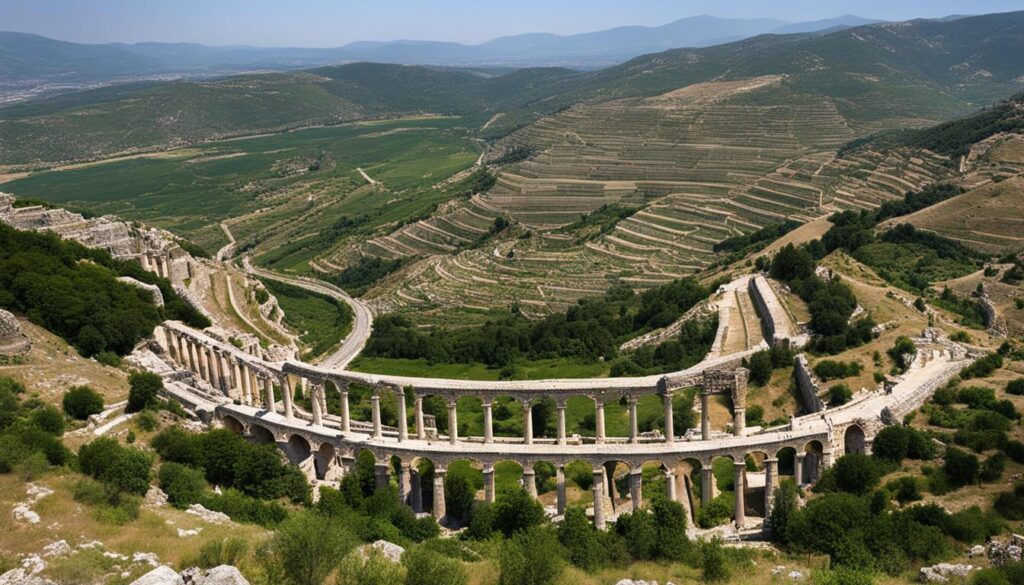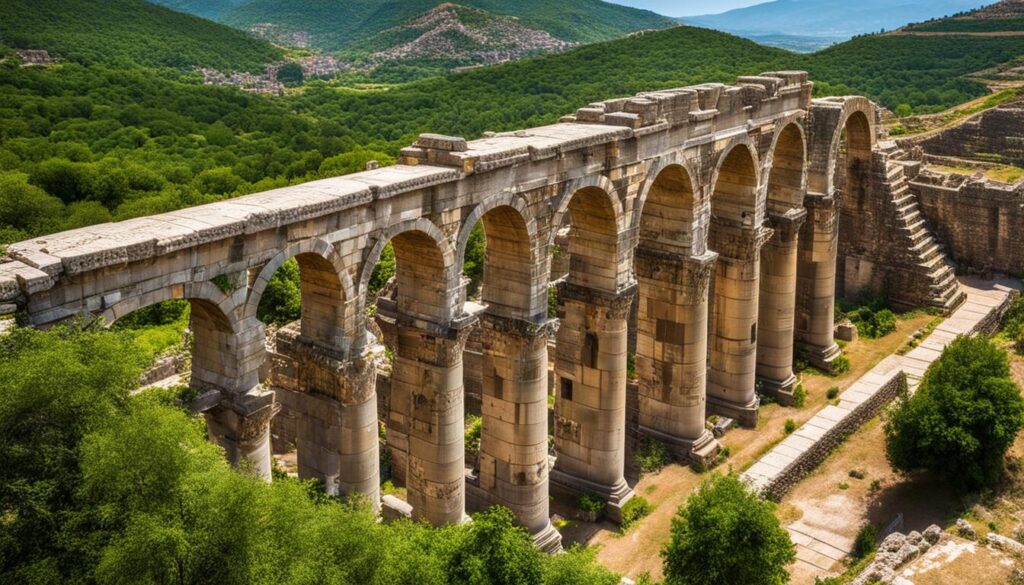If you want to travel back in time and explore ancient civil engineering marvels, look no further than Ephesus ancient aqueducts. These impressive structures served an essential purpose by providing a reliable water supply to the city of Ephesus in ancient times. In this article, we will delve into the historical significance behind these aqueducts, exploring their construction, design, functionality, and preservation efforts.
Whether you are an architecture enthusiast, a history buff, or simply curious about ancient civilizations, Ephesus aqueducts have something to offer. Join us on this journey as we uncover the fascinating story of water supply in ancient Ephesus and its lasting impact on the city’s development.
Introduction to Ephesus
If you’re interested in ancient history, Ephesus is a name you’re surely familiar with. This incredible ancient city has played a significant role in shaping the course of history, and it’s fascinating to explore the remnants of its past.
Ephesus dates back to the 10th century BC and has a long-standing history of being an important cultural and commercial hub in Asia Minor. The city has seen many different rulers and civilizations, including the Greeks, Persians, Romans, and Ottomans, each of which left their mark on the city.
From the Temple of Artemis, one of the Seven Wonders of the Ancient World, to the stunning Library of Celsus, Ephesus is home to some of the most significant historical and architectural achievements of antiquity.
With that said, let’s delve into the fascinating history of the ancient city of Ephesus and explore its many secrets and wonders, starting with the importance of water supply in ancient Ephesus. <?php echo("Ephesus”);?>
The Importance of Water Supply in Ancient Ephesus
Ancient Ephesus was a city that flourished due to its strategic location on the western coast of Asia Minor. However, its growth and prosperity were largely dependent on access to a reliable water supply.
Water was essential for numerous purposes, including daily household needs, irrigation of crops, and industrial activities such as textile production and metallurgy. Without adequate water, the development of the city would have been severely hindered.
The city’s water supply came from multiple sources, including springs, wells, and the nearby Cayster River. However, these sources were often insufficient to meet the needs of the growing population, especially during periods of drought or low rainfall.
As a result, the construction of aqueducts became a critical solution for ensuring a steady water supply. The aqueducts tapped into the nearby mountains to transport water to the city, utilizing an intricate system of channels and pipes that ran for miles.
Overall, the importance of water supply in ancient Ephesus cannot be overstated, as it enabled the city to thrive and achieve economic and cultural success.
Construction and Design of Ephesus Aqueducts
One of the most impressive features of the Ephesus aqueducts is their engineering marvels. The aqueducts were constructed using a combination of underground and above-ground channels made from various materials, including stone, brick, and cement.
The design of the aqueducts was unique and innovative, with arches and columns that allowed for even distribution of water pressure and increased stability. The aqueducts also featured sophisticated water filtration systems and storage tanks to ensure a reliable water supply.
The construction of the Ephesus aqueducts was a massive undertaking, requiring skilled labor and significant resources. The building process was meticulously planned and executed, resulting in a system of aqueducts that have stood the test of time.
Notable Features of Ephesus Aqueducts
| Feature | Description |
|---|---|
| Architectural Design | The use of arches and columns allowed for even distribution of water pressure and increased stability. |
| Water Filtration System | A sophisticated system of filters was employed to ensure the purity and safety of the water. |
| Storage Tanks | The aqueducts featured numerous storage tanks to ensure a consistent water supply throughout the city. |
| Materials Used | Stone, brick, and cement were used in the construction of the aqueducts, showcasing the advanced building techniques of the time. |
The Ephesus aqueducts are a testament to the advanced construction and architectural design of ancient civilizations, and they continue to inspire awe and admiration to this day.
Functionality of Ephesus Aqueducts
The aqueducts in Ephesus were a fundamental part of the city’s infrastructure. These impressive engineering feats provided a reliable and abundant water supply to meet various needs of the inhabitants.
The primary function of the Ephesus aqueducts was to transport water from the source, located several kilometers away, to the urban areas of the city.
The water was collected from natural springs and directed through channels to the aqueducts. From there, the elevated structures carried the water through the city, utilizing gravity to distribute it throughout the urban areas. The aqueducts enabled the citizens to access running water for various daily activities, such as drinking water, washing, and sanitation purposes.
The water supply was also crucial for sustaining agriculture in the surrounding areas. The aqueducts facilitated irrigation systems that supported the cultivation of crops and ensured a stable food supply for the population.
The functionality of the aqueducts proved to be essential for the development and prosperity of the ancient city of Ephesus. The reliable water supply enabled the citizens to flourish and pursue other aspects of life, such as culture, trade, and education. Moreover, the aqueducts secured the city’s future by forming a resilient infrastructure that could withstand external adversities.
Historical Significance of Ephesus Aqueducts
The Ephesus aqueducts were not only impressive feats of engineering but also had a significant impact on the ancient city. Providing a reliable water supply for daily life, the aqueducts fueled the growth of the city and its cultural development. They supplied water for public baths, fountains, and irrigation, which allowed agriculture to prosper in the region. Additionally, the construction of aqueducts required a tremendous amount of resources and manpower, providing employment opportunities and boosting the local economy.
These aqueducts stood as a symbol of urban advancement and technological prowess, which played a crucial role in shaping the identity of Ephesus as a center of Hellenistic culture. The knowledge and skills that went into designing and constructing these aqueducts were immensely valuable, inspiring generations of engineers and architects who continued to accept the challenges of engineering new and impressive structures.
“The aqueducts of Ephesus are not just a source of water supply but also an enduring testament to the technological and cultural achievements of ancient civilizations.”
Preservation and Restoration Efforts
As one of the most impressive engineering feats of the ancient world, the Ephesus aqueducts hold a significant place in history and culture. While these structures have withstood the test of time, preserving their integrity remains an ongoing challenge.
Thankfully, many organizations have taken on the task of restoring and preserving these ancient aqueducts for future generations to appreciate. The Turkish government, in particular, recognizes the importance of these structures and has dedicated significant resources toward their upkeep.
Restoration efforts have included reinforcing weakened areas, repairing damaged sections, and cleaning and protecting the aqueducts from environmental factors such as erosion and weathering. In addition, educational programs have been established to raise awareness about the importance of historic preservation and to promote the appreciation and understanding of ancient architecture and engineering.
The ongoing preservation and restoration efforts ensure that the Ephesus aqueducts continue to stand tall as one of the world’s most impressive engineering marvels and a testament to the culture and ingenuity of the ancient people who built them.
Ephesus Aqueducts in Modern Times
Despite being an ancient engineering marvel, the aqueducts in Ephesus continue to captivate and inspire people in modern times. As a UNESCO World Heritage site, they attract tourists and researchers from around the world, all eager to witness the incredible architectural feats of the past.
One of the most notable modern-day achievements involving the aqueducts is the conservation and restoration efforts to maintain their historical legacy. Today, there are numerous initiatives working to preserve the integrity of these ancient structures, ensuring that future generations can continue to appreciate their beauty and significance.
Image showing the aqueducts of Ephesus in modern times
Conclusion
Congratulations! You have now learned about the historical significance of the Ephesus ancient aqueducts. These architectural wonders not only showcased the engineering marvels of their time but also played a vital role in the development and sustainability of the ancient city of Ephesus. The importance of water supply in ancient civilizations cannot be understated, and it is evident in the efforts and resources invested in constructing these aqueducts.
The construction and design of these aqueducts showcase the remarkable engineering prowess of the people of Ephesus, and their functionality provided a reliable water supply for various purposes. These aqueducts were instrumental in shaping the city’s development and cultural aspects, serving as a living testament to the city’s rich history.
Today, the ongoing preservation and restoration efforts ensure that the Ephesus ancient aqueducts’ historical legacy is preserved for generations to come. The aqueducts continue to be admired and studied in modern times, attracting tourists and researchers from around the world.
In conclusion, the Ephesus ancient aqueducts remain an impressive feat of architecture and a valuable reminder of the importance of water supply in ancient civilizations. Their historical significance is undeniable and will continue to impact the world for years to come.

















































